Les prélèvements biologiques réalisés au cours des campagnes MERMED ont permis de définir le régime alimentaire du merlu, et de connaître les niveaux de contamination chimique pour différents composants, à chacun des échelons du son réseau trophique.
Les captures ont été effectuées sur le plateau continental du golfe du Lion, à plusieurs profondeurs et distances du déboucher du Rhône, avec deux chaluts (chalut MERMED, chalut MEDITS) et sur le talus avec des filets fixes.
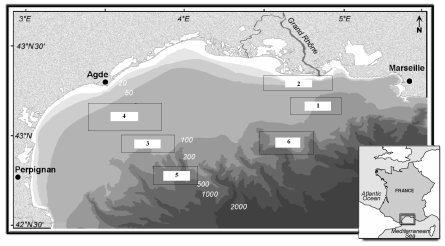
Stations d'échantillonnage des campagnes MERMED entre 2004 et 2006 dans le golfe du Lion
Réseau trophique du merlu (non publié, en cours)
Juveniles and adults hake feeding ecology was investigated from stomach contents and stable isotopes ( 15N,
15N,  13C) analyses during two seasons and over three years (2004-2006) on the continental shelf and slope in the Gulf of Lions. Relationships between prey and predator length were examined. Influence of different factors on
13C) analyses during two seasons and over three years (2004-2006) on the continental shelf and slope in the Gulf of Lions. Relationships between prey and predator length were examined. Influence of different factors on  15N variations were then investigated with GLMs. Trophic web was built from isotope analyses. The major food sources for hake were crustacean and fish. An ontogenetic diet shift from crustaceans to fish was confirmed during juvenile stage. Pelagic fish played a major role as trophic resources (40-80%) in adult stages, but cannibalism was low (<5%). Diet composition varies with hake body length, depth and year.
15N variations were then investigated with GLMs. Trophic web was built from isotope analyses. The major food sources for hake were crustacean and fish. An ontogenetic diet shift from crustaceans to fish was confirmed during juvenile stage. Pelagic fish played a major role as trophic resources (40-80%) in adult stages, but cannibalism was low (<5%). Diet composition varies with hake body length, depth and year.
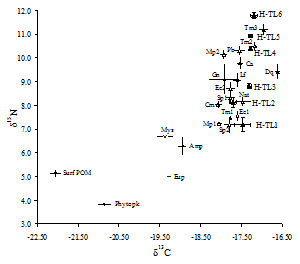
Mean (± SE)  15N (
15N ( ) and
) and  13C (
13C ( ) for main preys (open symbols) of hake (solid symbols) trophic web in the Gulf of Lions in 2005.
) for main preys (open symbols) of hake (solid symbols) trophic web in the Gulf of Lions in 2005.
Modèle DEB sur une famille de contaminants, les PCB (Bodiguel et al 2009)
The model presented effectively describes growth and accumulation of PCBs during the life cycle of both male and female hakes. It accounts for the effects of growth, physiological condition (i.e. proportion of reserve), and reproduction on observed concentrations in two hake populations. Levels and evolution of 4 PCB congeners concentrations are well reproduced in two study areas: the Gulf of Lions (Mediterranean sea) and the Bay of Biscay (Atlantic ocean). This suggests that the basic assumptions of the model are valid and that the approach is adapted to study the fate of contaminants in fish. Study of less lipophilic compounds can be envisioned with this approach, including the uptake of contaminants through the gills and the biotransformation processes. Finally, the internal consistency of the proposed model of organic contaminant bioaccumulation sets the stage for a mechanistic understanding of toxicity and ecological effects of organic contaminants in marine organisms. Some contaminants are considered to alter energy use by causing energy loss or poor energy management. Including those toxicity phenomena into our bioaccumulation model would allow to model the effects of contaminants on physiological functions.
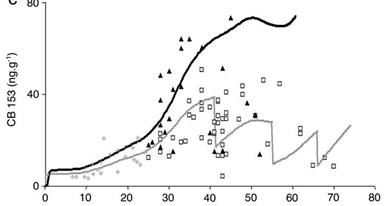
Simulated concentrations of PCBs (ng g-1 W) as function of length for female (grey line) and male (black line) hake in the Gulf of Lions and the Bay of Biscay, for a period of 10 years. In the Gulf of Lions measured concentrations (symbols) distinguish undetermined sex hakes (light grey squares), females (white squares) and males (black triangles).
Influence du sexe, de la maturité et de la reproduction sur les PCB (Bodiguel et al 2009)
This study presents variations of PCB and p,p'DDE contamination in muscle, liver and gonad of male and female hake from the Gulf of Lions. Observed levels appeared higher than the population of the Bay of Biscay and lower than the population of the Thyrrenian Sea. Contaminant fingerprints were roughly constant whatever the studied tissue and the hake biological condition. Results highlight the influence of sex, maturation degree and reproduction on levels and kinetic of PCBs and p,p'DDE. Higher levels observed in males compared than females can be linked to a lower growth rate of males, and a contaminant elimination during female spawning. Spawning represents an important mechanism for the elimination of contaminants. Although the main organ of energy and PCB storage is the liver, muscle is the main contributor to the gonad contamination. Finally, the results show the necessity to take into account the processes of maturity and reproduction cycle when modeling the bioaccumulation of persistent hydrophobic contaminants in fish, and especially the role of muscle in the gonad contamination.
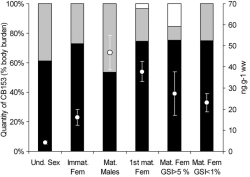
Organ contribution to the total CB153 body burden (%) in the sixth stage (liver is represented in black, muscle in grey and gonads in white) and CB153 concentration (ngg-1 ww) in whole fish (white circle).
Influence de la biodisponibilité, de la position trophique et de la croissance sur le méthylmercure chez des merlus du golfe du Lion (Cossa et al soumis à Environmental Science and Technology)
Methylmercury (MeHg) determinations in hake, its food-chain, and the surrounding waters and sediments, allowed us to show that the higher length or age normalized mercury concentrations of North-western Mediterranean muscle hakes compared to its North-eastern Atlantic counterpart are due to both biotic and abiotic differences between their ecosystems. Bioenergetic modeling reveals that the slower growth rate of Mediterranean hake favors the MeHg bioaccumulation in the fish muscle and explains most of the difference between GOL and BoB hake populations. In addition, the waters of the Mediterranean hake habitat favor a higher MeHg exposition, due to the upper position of the thermohalocline, where MeHg is formed. Furthermore, we show that, within the Mediterranean hake population, a major increase in the biomagnification power (the slope of the relationships between logMeHg and  15N), from 0.36 up to 1.12, occurs when individuals enter adulthood, resulting from the combined effects of lowering growth rate and change in feeding habits. Finally,
15N), from 0.36 up to 1.12, occurs when individuals enter adulthood, resulting from the combined effects of lowering growth rate and change in feeding habits. Finally,  15N normalized Hg concentrations indicate that the highest Hg concentrations are for hake from the shelf edge and the lowest for hake from the Rhône River plume area, suggesting a lower Hg bioavailability in inshore environments, consistent with both MeHg distributions in water and sediment.
15N normalized Hg concentrations indicate that the highest Hg concentrations are for hake from the shelf edge and the lowest for hake from the Rhône River plume area, suggesting a lower Hg bioavailability in inshore environments, consistent with both MeHg distributions in water and sediment.
Différence de biomagnification entre PCB, PBDE, mercure et Césium dans le réseau trophique du merlu (Harmelin et al., 2012)
The results obtained on hake food web contamination in the Gulf of Lions pointed out that contaminants behave fundamentally differently from one type to the other in spite of general common patterns of increase with trophic level. These differences are mainly linked to their physico-chemical properties and their bioaccumulation and elimination processes, but are modulated by the biology (growth, reproduction, diet) and ecology of the fish species. In a general context of contaminant load increase in coastal waters, understanding the processes of contaminant transfer along food webs according to the different proprieties of contaminants stays a challenging problem, particularly in the Mediterranean Sea where oligotrophy may favour contaminant accumulation at the base of the food chain.
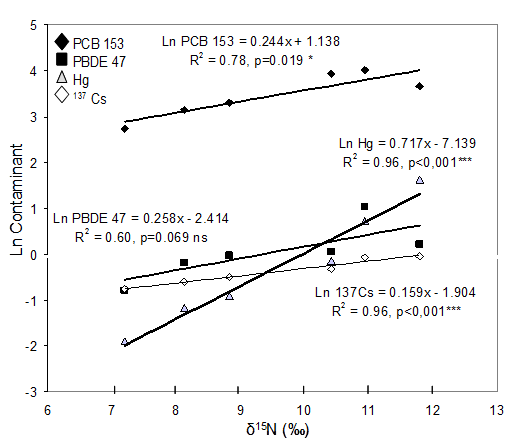
Linear relationships between lncontaminant concentration (dry weight) and d15N in hake muscle in the Gulf of Lions for the 4 types of contaminants analysed. Concentration units: CB-153, lg kg-1 dw; BDE-47, lg kg-1 dw; Hg, mg kg-1 dw;137Cs, Bq kg-1 dw.


 15N,
15N, 
 ) and
) and 


